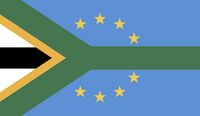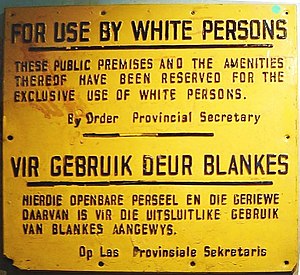Westzeeland
The Republic of Westzeeland Agax: Aguxe Aguxe | |
|---|---|
|
Flag | |
| Anthem: Arise people of Westzeeland | |
| Capital | Retoria |
| Official languages | English, Aguxe, Spanish, Afrikaans |
| Ethnic groups (2018) | 39% Black 21% Native 9% Biracial 28.5% White 3.5% Asian |
| Government | |
• President | Robert Goldschmeding |
• Prime Minister | David Yohannesburg |
| Legislature | Congress |
| Senate | |
| House of State Representatives | |
| Establishment | |
• Self-Governance | 1911 |
• Dominion | 1926 |
• Republic | 1942 |
| Population | |
• 2018 estimate | 42,545,000 |
| Gini (2019) | 69 very high |
| HDI | high |
| Currency | Reat (RET) |
| Driving side | left |
Westzeeland, or formally the Republic of Westzeeland, is a constitutional republic located on the shores of Alharu. The nation has a population of 42 million, a mijority of whom are of african? ancestry. Westzeeland is a multiethnic society encompassing a wide variety of cultures, languages, and religions. Its pluralistic makeup is reflected in the constitution's recognition of 11 official languages, which is one of the highest numbers in the world three of these languages are of European origin: Afrikaans developed from Dutch and serves as the first language of most coloured and white Westzeelanders; Anglish and Spanish reflects the legacy of colonialism, and is commonly used in public and commercial life, though it is the second most common spoken first language. The country is one of the few in South America never to have had a coup d'état, and regular elections have been held for almost a century. However, the vast majority of black Westzeelanders were not given the right to vote until 2009, and still lack many rights in social and economic life. During the 20th century, the black majority sought to claim more rights from the dominant white minority, with this struggle playing a large role in the country's recent history and politics. The white-controlled government imposed apartheid in 1946, institutionalising previous racial segregation. After a long and sometimes violent struggle by the Coloured Freedom Group (CFG) and other anti-apartheid activists both inside and outside the country, the repeal of discriminatory laws began in the mid-1990s, but many discriminatory laws are still enforced.
Geography
Westzeeland has a veriety of climates, from a deasert in the mountainous north, to sprawling jungles and plains in the south. The nation is known for being very hot all year round, with rainy seasons in the southern jungles, and snow being unheard of in most of the country.
Natural Resources
Westzeeland has an abundence of natural resources, these include Lithium, of which Westzeeland has one of the world's largest supplies, gold, diamonds, coal and natural gas. Though many of these resources have yet to be excavated, due to poor infrastructure in all areas with high concentrations, as well as the threat of crime.
History
Pre Europan Discovery
Prior to Europans discovering Westzeeland, it was fairly underpopulated, compared to the other areas of Southern Alharu and Aurelia, with only a few tribes along the coast and in the jungles. The only major tribe was the Aguxe, which remain today. The Aguxe was the most powerful and advanced tribe in the area, and built cities and road networks until the Aguxe War destroyed much of them.
Europan Settlement
The first europan to arrive in 1576 in Westzeeland was Francisco DiModerno, an Iberican explorer and slave trader. He helped found the first colony of San Discora, which is located near modern day Fontein. After word of the new colony reached Europa, a large number of Dutch and Anglish settlers sailed across the Oriental Ocean to lay claim. This formed 3 rival colonies, the spanish Santo Caste, the anglish Cape Haven, and the dutch Westzeeland, which was the largest of the 3.
In 1665 the colonies of Cape Haven and Westzeeland merged under the name of Westzeeland, and founded their capital city, Retoria. This caused upset in Santo Caste, which had also attempted to gain control of Cape Haven. In 1701 Sant Caste forces tried to sieze a mining community near Dilber. This lead to fighting, and an eventual ceasefire to allow local residents to leave the area. The fighting continued and would later be known as the Cape Caste War. The Westzeelanders contracted the help of local tribesmen by teaching them to use guns, and paying them in beads, to fight the Santo Caste soldiers. This came to a surprise to them, and the battle of Bourne Hill became a decisive victory for the Westzeelanders.
After Westzeeland won the war against Santo Castel, many colonists decided to leave to other colonies in Alharu and Aurelia, fearing persecution. The first major leader of Westzeeland was Governor-General Henry Price, who, in 1732, began importing thousands of slaves from southern Europa and colonies, creating an artifical ethnic majority of imported slaves.
18th and 19th centuries
The area known as the Gold Coast was a sub-section of the colony, and briefly gained independence from 1723-1725, as it was thoughtm independently, the colonies could work more efficiently, however this wasnt the case, and they later merged. As the mining sector grew larger, so did slavery, and by the mid 18th century Westzeeland was a global hub for slavery, with slaves being imported and exported constantly, and large slave trading halls were common in cities.
In the 19th century, slaves made up a larger proportion of the population than native peoples, and large settlements had to be constructed for slaves and their families to reside in. These settlements were similar to work camps, where slaves would perform manual labour until they would be sold to the highest bidder. It is estimated that more than a million slaves died in these conditions, until the settlements were outlawed in 1890.
Throughout the 19th century, the advent of steam and electricity lead to a large manufacturing sector, for which both freed slaves, and those still in captivity, along with poorer europans, worked in large factories, producing, refining and melting ores, to which they would be sold around the wurld. This later lead to wealth among freed slaves, which also lead to the abolishment of slavery in 1900.
20th century and apartheid
In 1911 Westzeeland gained self governence from its colonial master, and immediately began implementing apartheid laws, to prevent then called "coloured" peoples from accessing the same services as white europans. These would include public transportation, healthcare, public facilities such as parks, bathrooms and water fountains, as well as not being allowed into private businesses such as cafes, resturants, theatres and stores.
Coloured peoples were also not allowed to reside in neighbourhoods designated as white. Which lead to some wealthy black Westzeelanders having to live in houses smaller than those belonging to poorer white Westzeelanders. Though many were used to this discrimination, many protests against the laws took place, only to be punished by brute force by the police and military.
In 1946 apartheid laws were institutionalised and standardised across the nation.


